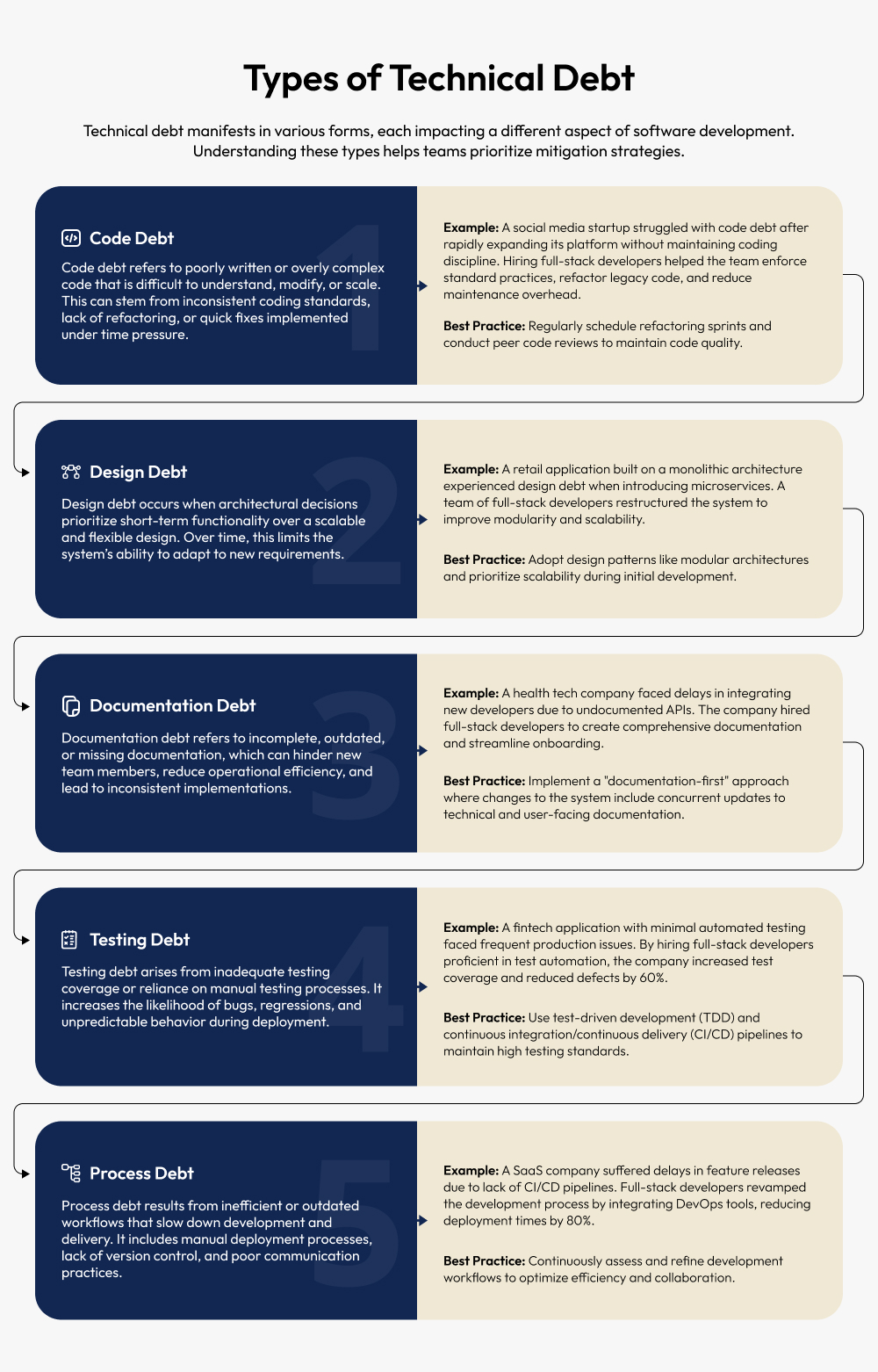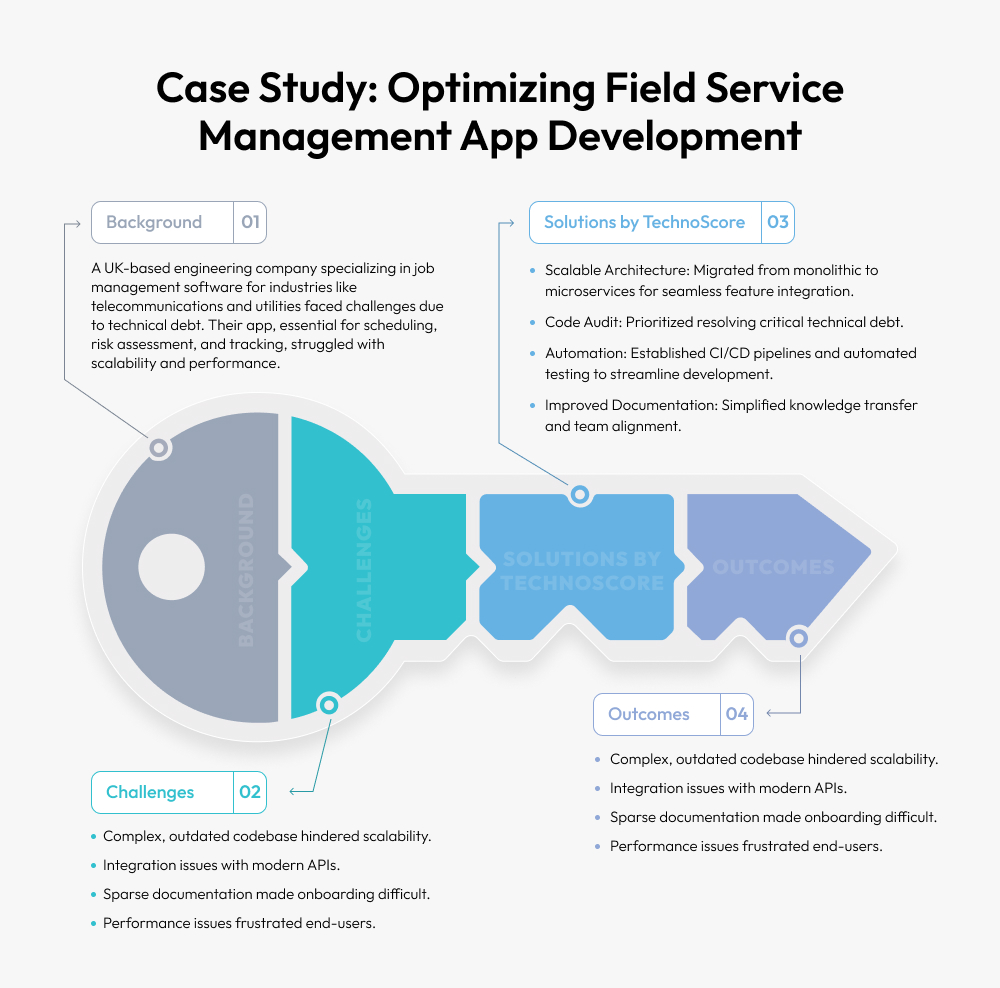
Technical debt refers to the future costs incurred when software development teams take shortcuts to expedite delivery, often resulting in suboptimal code or architecture. While these shortcuts can lead to immediate gains, they frequently cause increased maintenance costs, reduced productivity, and hindered scalability over time.
Recent studies highlight the significant impact of technical debt on organizations.
For instance, a 2024 report revealed that enterprises are grappling with approximately $1.52 trillion in software technical debt, with 51% dedicating more than a quarter of their annual IT budgets to remediation efforts.
A real-world example is Stack Overflow’s experience with technical debt. The platform faced challenges due to accumulated debt, which complicated the implementation of new features and maintenance. By acknowledging and addressing these issues, Stack Overflow successfully refactored critical parts of its system, enhancing performance and developer productivity.
Understanding and managing technical debt is crucial for maintaining software quality and ensuring sustainable development practices.
The Role of Full-Stack Developers in Managing Technical Debt
Full-stack developers, with their comprehensive understanding of both front-end and back-end systems, are instrumental in identifying and mitigating technical debt. Their holistic perspective enables them to detect inefficiencies across the entire application stack, ensuring that quick fixes in one area do not lead to complications elsewhere.
For example, in a Finnish software company, the absence of a specific management plan for reducing technical debt led to quality issues and economic consequences. Full-stack developers can implement best practices, such as code reviews and automated testing, to prevent such debt accumulation.
Moreover, full-stack development services can introduce modern tools and methods that enhance code quality and maintenance. Tools like CodeScene provide insights into code health, helping teams prioritize technical debt mitigation efforts effectively.
By employing their diverse skill set, full-stack developers play a pivotal role in maintaining the integrity of software systems, ensuring that technical debt is managed proactively to support long-term project success.
Understanding Technical Debt
Causes of Technical Debt
Technical debt arises from a variety of factors, often driven by short-term goals that overshadow long-term sustainability. Among the most common causes are tight deadlines, insufficient resources, and poorly defined requirements. For instance, when a development team prioritizes speed over quality, they might bypass software development best practices, such as thorough code reviews or adhering to robust design principles.
Other contributors include:
- Lack of technical expertise: Inexperienced teams may introduce inefficiencies unknowingly.
- Over-reliance on legacy systems: Older architectures can accumulate technical debt due to compatibility issues with modern tools and frameworks.
- Rapid scaling: As companies grow, hastily built solutions can create bottlenecks and inefficiencies.
A notable example is the 2017 Equifax data breach, where unresolved technical debt in the form of unpatched software vulnerabilities exposed sensitive information. Addressing these root causes is essential to preventing such costly consequences.

The Real Costs of Technical Debt
Technical debt, while often treated as an abstract concept, has tangible and far-reaching consequences for organizations. Its effects financial resources, team dynamics, and competitive positioning, ultimately determining the success or failure of projects. Below, we tap into the multifaceted costs of technical debt, particularly in the context of full-stack development challenges.
1. Financial Costs
Technical debt directly impacts an organization’s bottom line. Addressing poorly written code, outdated architecture, or inefficient systems demands significant resources. According to a 2024 survey by the Standish Group, the average enterprise spends 20-40% of its software budget addressing technical debt, translating to billions of dollars annually.
For instance, a multinational retailer faced a surge in operational costs due to the accumulation of technical debt in its e-commerce platform. Over time, the inefficiencies in the back-end systems resulted in 40% higher server costs and extended downtime during peak shopping periods, leading to lost sales and customer dissatisfaction. By proactively addressing the debt through refactoring and upgrading their tech stack, the company was able to save over $15 million annually.
In full-stack development, technical debt is particularly acute due to the need to balance front-end user experience and back-end efficiency. When one layer is optimized at the expense of another, repair costs ripple across the stack, increasing remediation expenses.
2. Productivity Loss and Team Morale
Technical debt slows development velocity, making new features harder to implement and existing functionality more difficult to maintain. Developers often spend 40-50% of their time addressing legacy issues instead of focusing on innovation. This challenge is magnified in full-stack development, where the integration between layers often exposes hidden dependencies and bottlenecks.
Teams regularly encountering the same issues due to unresolved technical debt may experience frustration and burnout. For example, a tech startup attempting to scale quickly faced significant morale challenges when its team spent six months fixing the same recurring bugs caused by outdated dependencies in their stack. Developer turnover increased by 30%, costing the company an additional $100,000 per departed employee in lost productivity and retraining costs.
3. Business and Competitive Impact
Beyond financial and internal team costs, technical debt can have profound implications for a company’s market position. Delayed feature rollouts, unreliable performance, and reduced system scalability can erode customer trust and loyalty.
For example, when a leading SaaS provider struggled to integrate new features due to deeply embedded technical debt, its competitors seized the opportunity to launch similar offerings faster. This delay caused a 10% decline in market share, which translated into millions of dollars in lost annual revenue.
In full-stack development, where agility and responsiveness are critical, technical debt impedes the ability to stay ahead of competitors. Teams bogged down by outdated frameworks or poorly designed APIs cannot pivot quickly to meet emerging market demands.
The Compound Effect of Full-Stack Development Challenges
Managing technical debt in full-stack development presents unique challenges due to the interconnected nature of the work. A seemingly minor front-end decision—such as choosing a library for a user interface—can cascade into back-end inefficiencies, forcing teams to reconcile decisions made across the stack. These ripple effects intensify the overall costs and complexity of managing technical debt, making proactive planning and robust communication essential.
Is technical debt holding your software back from its full potential?
Our full-stack development services focus on managing technical debt and ensuring maintainable, scalable solutions.
Agile Development Pitfalls
Agile development fosters speed, adaptability, and collaboration, but without proper checks, it can exacerbate technical debt. One common pitfall is prioritizing rapid delivery over long-term maintainability. This approach often leads to rushed coding, incomplete testing, and overlooked documentation, which accumulate into technical debt. Another issue arises when Agile teams skip retrospectives or fail to allocate time for refactoring, pushing unresolved debt into future sprints. Miscommunication among cross-functional teams also contributes, as unclear requirements or misaligned goals result in suboptimal implementations. To avoid these pitfalls, teams must balance speed with quality, ensuring every iteration contributes to a sustainable and scalable product.
Full-Stack Developers: Preventing Development Nightmares
Full-stack developers play a critical role in managing technical debt due to their ability to oversee both front-end and back-end operations. Their holistic perspective helps identify and mitigate potential issues before they escalate into significant challenges. Here’s how they contribute effectively:
How Full-Stack Developers Spot Technical Debt Early
Full-stack developers excel at identifying inconsistencies across the tech stack. They can detect frontend-backend mismatches, inefficient database queries, or poorly implemented APIs. By examining the codebase holistically, they recognize potential bottlenecks or areas prone to breakage during scaling. Their experience allows them to spot patterns in poorly documented or outdated code and implement preventive measures such as modular architecture or optimized algorithms.
Tools and Techniques Full-Stack Developers Use
Leveraging tools like SonarQube, full-stack developers monitor code quality and identify areas of concern. They rely on CI/CD pipelines to automate builds and tests, catching errors before they reach production. Version control platforms like GitHub help track changes and maintain code integrity. Pair programming, code reviews, and static code analysis are additional techniques that ensure the code remains maintainable and scalable. By integrating these tools into their workflow, full-stack developers create a robust defense against accumulating debt.
Collaborating Across Teams to Mitigate Debt
Full-stack developers act as a bridge between teams, facilitating better communication and alignment. They help product managers understand the trade-offs between immediate feature releases and long-term maintainability, ensuring technical debt is factored into planning. Collaboration with DevOps teams ensures infrastructure and deployment pipelines are efficient, reducing operational debt. By fostering a culture of shared accountability, full-stack developers encourage team members to prioritize quality and sustainability.
Strategies for Managing Technical Debt
Managing technical debt requires deliberate strategies to balance immediate needs with future scalability. Here are actionable approaches that ensure teams remain agile while maintaining code quality:
Prioritization Frameworks
MoSCoW Approach
The MoSCoW approach organizes tasks by prioritizing them into four categories: Must-haves, Should-haves, Could-haves, and Won’t-haves. This prioritization helps teams focus on essential debt that impacts functionality while deferring less critical issues. For example, addressing a critical security vulnerability (a Must-have) would take precedence over cleaning up redundant code (a Could-have). This framework ensures debt resolution aligns with business goals and resource availability.
Risk-Adjusted Backlogs
Risk-adjusted backlogs prioritize tasks based on their potential impact. For example, a piece of legacy code integral to core functionality might be prioritized higher than a feature-specific bug. This approach considers both the likelihood of failure and the consequences, enabling teams to mitigate high-risk debt before it causes significant disruptions.
Agile Practices for Reducing Debt
Agile practices can actively reduce technical debt when implemented effectively. Adding “debt stories” to sprints ensures time is allocated for addressing outstanding issues. Regular retrospectives allow teams to review what caused the debt and implement corrective actions. Transparent communication about the trade-offs between speed and quality helps avoid introducing new debt while managing existing liabilities.
Automation and Refactoring: Reducing Debt Efficiently
Automation plays a vital role in maintaining clean, efficient codebases. Automated testing identifies bugs early, ensuring quality without adding overhead. Continuous integration and deployment pipelines streamline development, reducing errors during production. Refactoring, when done iteratively, improves code structure and maintainability without disrupting ongoing work. Together, automation and refactoring create a workflow that prevents technical debt from growing unchecked while enhancing the system’s overall stability.
Software Development Best Practices
Adopting software development best practices ensures code quality, scalability, and maintainability. These practices include adhering to coding standards, fostering collaboration through code reviews, and implementing automated testing. Full-stack developers play a critical role by bridging the gap between front-end and back-end processes, ensuring consistency across the stack. By prioritizing modular design and efficient use of resources, teams can reduce the likelihood of accumulating technical debt while creating a strong foundation for future growth.
Best Practices for Full-Stack Developers
Writing Scalable and Maintainable Code
Creating scalable and maintainable code is fundamental for long-term success in software projects. Full-stack developers should focus on modularity, reusable components, and clear naming conventions. Techniques like writing DRY (Don’t Repeat Yourself) code, using modern frameworks, and implementing design patterns enhance the code’s adaptability and reduce technical debt. For instance, well-structured APIs and database schemas not only simplify integrations but also make the system more resilient to future changes.
Importance of Documentation and Testing
Proper documentation ensures that every team member can understand and contribute to the project efficiently. It’s vital to provide clear inline comments, maintain API documentation, and include user guides for smooth onboarding and troubleshooting. Coupled with robust testing practices such as unit tests, integration tests, and end-to-end tests, documentation significantly minimizes bugs and accelerates debugging. Automation in testing further guarantees that systems remain reliable as they scale, ensuring sustainable development.
Continuous Learning and Upskilling
Technology evolves rapidly, and full-stack developers must stay updated with the latest tools, frameworks, and best practices. Regularly attending workshops, enrolling in online courses, and exploring hands-on projects help developers remain competitive. By learning new methodologies such as low-code development or mastering emerging languages, developers can future-proof their skill sets and contribute more effectively to reducing technical debt.
Proactive Debt Prevention: Building Resilient Systems
Investing in Low-Code Platforms
Low-code platforms empower developers to build applications faster and with fewer errors, making them a valuable tool for mitigating technical debt. By leveraging visual development tools and prebuilt templates, these platforms reduce coding complexity and improve collaboration between technical and non-technical teams. Low code also facilitates seamless integrations and ensures that applications are automatically updated with the latest security and performance standards, promoting system resilience.
Integrating Continuous Debt Management into Workflows
Continuous debt management involves identifying and addressing technical debt as part of regular development cycles. Full-stack developers should incorporate refactoring tasks into Agile sprints and prioritize addressing high-impact issues during retrospectives. Establishing a culture of quality where technical debt is monitored and acted upon proactively prevents accumulation, ensuring smoother development processes and a healthier codebase.
Key Metrics to Monitor Technical Debt
Tracking technical debt with relevant metrics helps teams quantify and prioritize debt management. Metrics such as code complexity, code churn rate, and remediation cost provide insights into the current health of the codebase. Tools like SonarQube can automate debt detection, offering actionable data to guide refactoring efforts. By regularly monitoring these indicators, teams can make informed decisions to balance feature development and debt resolution effectively.
Conclusion
Technical debt is an inevitable part of software development, but its impact can either be a manageable tradeoff or a development nightmare, depending on how it’s addressed. For businesses striving to deliver innovative solutions while maintaining code quality, understanding and proactively managing technical debt is crucial. The role of skilled professionals, particularly full-stack developers, cannot be overstated. Their expertise ensures that systems are not only functional but scalable and maintainable, helping to reduce long-term costs and improve agility.
The Hidden Costs of Technical Debt
Technical debt goes beyond just messy code—it affects project timelines, team productivity, and business outcomes. The hidden costs include higher maintenance expenses, delayed feature rollouts, and even decreased morale among development teams. Ignoring debt compounds these issues, leading to larger risks such as system failures or missed market opportunities. Hiring full-stack developers who understand the end-to-end architecture of systems is a strategic way to mitigate these risks. Their ability to address both front-end and back-end challenges ensures that debt is identified and resolved early, preserving the system’s health and scalability.
Managing Debt for Sustainable Development
To build resilient, future-proof software, businesses must prioritize technical debt management as a continuous effort. Implementing best practices like code reviews, automated testing, and modular design helps teams tackle debt incrementally. Moreover, leveraging tools to monitor and measure debt ensures that it remains within manageable limits.
For organizations aiming to strike the perfect balance between rapid development and long-term code quality, the solution is clear: hire full-stack developers with the expertise to navigate complex systems and prevent technical debt from spiraling out of control. Their holistic approach and ability to deliver maintainable solutions are invaluable assets to any software development effort.
Start today by auditing your codebase, investing in skilled professionals, and adopting practices that prioritize sustainable development—because managing technical debt isn’t just about fixing problems; it’s about building a foundation for growth and innovation.


